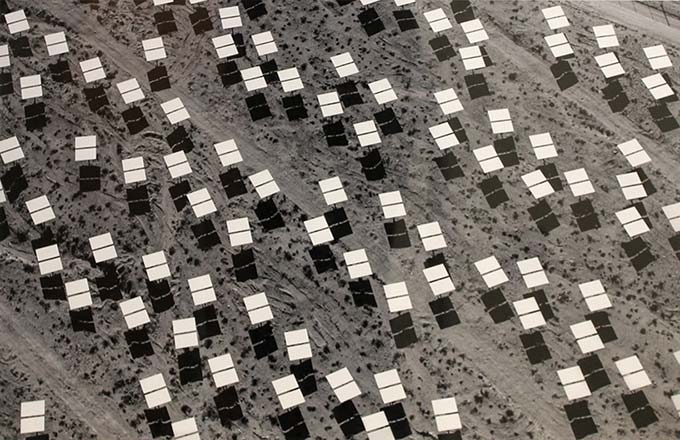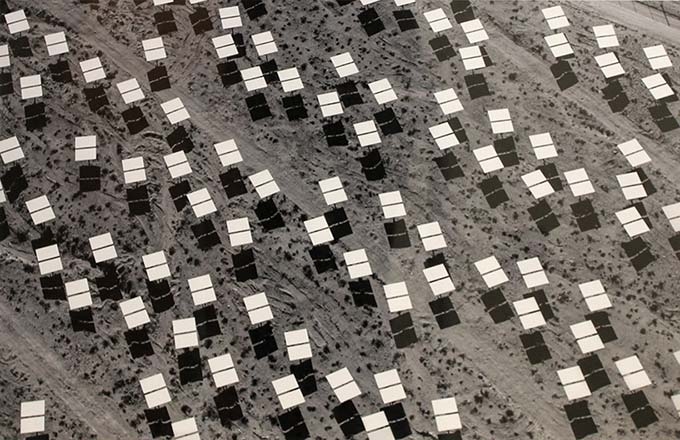Photographer Jamey Stillings Lectures on Energy and the Environment

Visualizing Renewable Energy
October 17, 2017, 4:30 p.m., Room 221, Mahaney Center for the Arts
For immediate release: 9/26/17
For further information contact: Emmie Donadio, at donadio@middlebury.edu or (802) 443-2240
Middlebury, VT—Santa Fe-based photographer Jamey Stillings will speak on “Visualizing Renewable Energy” on Tuesday, October 17, at 4:30 p.m. in Room 221 of Middlebury College’s Mahaney Center for the Arts. An artist featured in the current museum exhibition Land and Lens: Photographers Envision the Environment, Stillings will be visiting Middlebury under the auspices of the Johnson Visual Arts Residency at the College.
As an environmental activist whose photographic projects focus on what the artist describes as sites “at the intersection between nature and human activity,” Stillings is best known for his bird-eye views of the Hoover Dam and the Ivanpah Solar Project, in the Mojave Desert of California. He has given a TED talk, published photographs in The New York Times Magazine, Newsweek, and WIRED, and participated in exhibitions at the Chicago Museum of Contemporary Photography. His photographs are in the collections of the Museum of Fine Arts in Houston, the Nevada Museum of Art, the Library of Congress, and the Middlebury College Museum of Art, among other public institutions. His photographic monograph The Bridge at Hoover Dam, published in 2011, was followed by The Evolution of Ivanpah Solar, in 2015.
The Ivanpah Solar Electric Generating System, which has held Stillings’s attention since its conception in 2010, is a 3,500-acre solar energy facility on federal land near the border between California and Nevada. Hailed during its construction phase by former President Clinton, then-President Obama, and then-Governor Schwarzenegger for its advanced technology as well as for employing 2,600 workers, it is now one of the world’s largest sources of solar thermal electrical power. Ivanpah relies on 300,000 mirrors, each the size of a garage door, to capture the sun’s energy and to transfer the heat onto solar receiver towers which in turn drive a gigantic steam-producing turbine. The plant generates 377 megawatts of electricity—enough to fuel 140,000 California homes on a normal day. Stillings was given air rights to photograph the construction of the site, which has been in operation since 2013.
While he has documented massive industrial complexes from the air, Stillings is most engaged by the stories of how these energy-producing plants have come about through the political efforts of their designers on the ground. The process of negotiating such ambitious projects is of great interest to the artist, and he is equally comfortable discussing the 400,000-ton annual reduction of carbon dioxide emissions made possible by Ivanpah’s clean energy as well as the distressing number of desert tortoises that have had to be relocated since its creation. A passionate advocate of renewable energy sources and of a culture of sustainability, Stillings has no illusions about the lack of easy solutions to the earth’s environmental problems.
Land and Lens will remain on view at the Museum through December 10.
Press Image

Jamey Stillings, #6425, 2 June 2012, from the portfolio The Evolution of Ivanpah Solar, 2012, gelatin silver print, 20 x 28 inches. Collection of Middlebury College Museum of Art. Gift of Bread Loaf Corporation, Architects, Planners, Builders, 2013.010.
The Middlebury College Museum of Art, located in the Kevin P. Mahaney ’84 Center for the Arts on Rte. 30 on the southern edge of campus, is free and open to the public Tues. through Fri. from 10 a.m. to 5 p.m., and Sat. and Sun. from noon to 5 p.m. It is closed Mondays. The museum is physically accessible. Parking is available in the Mahaney Center parking lot. For further information and to confirm dates and times of scheduled events, please call (802) 443–5007 or TTY (802) 443–3155, or visit the museum’s website at museum.middlebury.edu.
